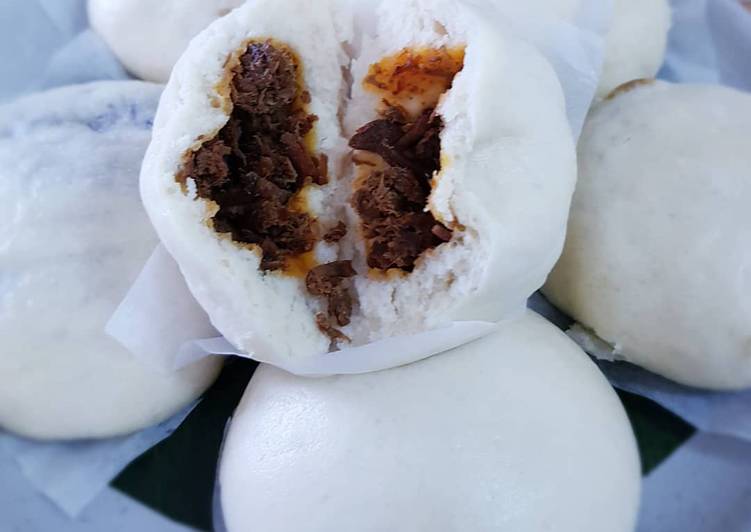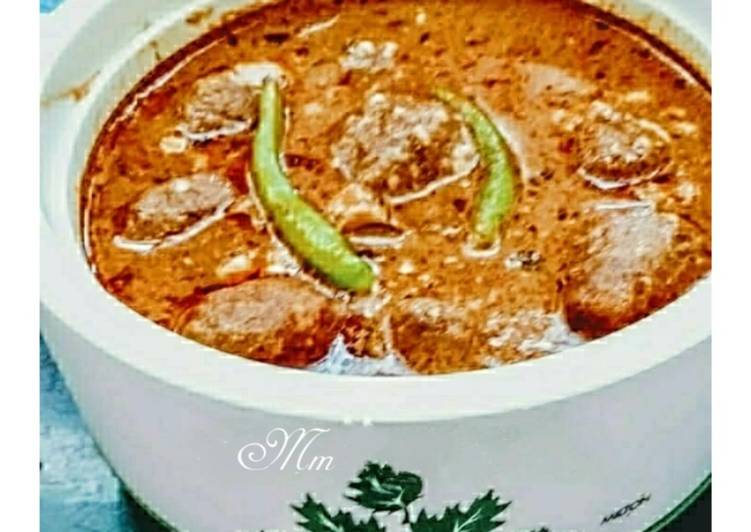
Hey everyone, it is Brad, welcome to my recipe site. Today, I will show you a way to prepare a distinctive dish, bakpao isi rendang (steamed buns with rendang filling). One of my favorites food recipes. This time, I will make it a bit tasty. This is gonna smell and look delicious.
See recipes for Halal Pao Bun (Xialongpao / Bakpao), Bakpao too. Bakpao Isi Rendang (Steamed Buns with Rendang filling) high protein flour, sugar, instan yeast, baking powder, ice water, butter, salt. Add ice water little by little to the mixture of dry ingredients, knead until smooth.
Bakpao Isi Rendang (Steamed Buns with Rendang filling) is one of the most favored of current trending meals on earth. It’s appreciated by millions every day. It is easy, it is quick, it tastes delicious. Bakpao Isi Rendang (Steamed Buns with Rendang filling) is something which I’ve loved my whole life. They are nice and they look wonderful.
To begin with this recipe, we have to prepare a few components. You can have bakpao isi rendang (steamed buns with rendang filling) using 7 ingredients and 5 steps. Here is how you can achieve that.
The ingredients needed to make Bakpao Isi Rendang (Steamed Buns with Rendang filling):
- Prepare 450 gram high protein flour
- Prepare 50 gram sugar
- Prepare 1 1/2 teaspoon instan yeast
- Take 1 teaspoon baking powder
- Get 240 ml ice water
- Take 2 tablespoon butter
- Get 1/2 teaspoon salt
Resep Bakpao Telo Ungu Ncc, Resep Bakpao Tangmien, Resep Bakpao Tepung Pao,. See great recipes for My fried Salt and Pepper seasoned Chicken on a bun. 🥰🥰🥰 too! To make bunny buns, make two incision on the top, creating a V shape, while for the hedgehog, basically you just kinda make a cut here and there without cutting through the buns :) Bakpau, bakpao or bah-pau (Chinese: 肉包; pinyin: ròubāo; Pe̍h-ōe-jī: bah-pau; Javanese: ꦧꦏ꧀ꦥꦲꦸ, romanized: bakpau) is a Chinese Indonesian dish, type of Chinese bun filled with meat, usually minced pork. The name bakpau originates from the Hokkien word for "meat bun", though "meat" in Chinese culture usually refers to pork by default in the absence of other descriptors.
Instructions to make Bakpao Isi Rendang (Steamed Buns with Rendang filling):
- Mix flour, sugar, baking powder, butter and instant yeast. Sift, then stir well.
- Add ice water little by little to the mixture of dry ingredients, knead until smooth. Add butter and salt, knead with the help of a mixer (rest the mixer every 10 minutes to keep it from getting too hot). Knead until smooth elastic, then round the dough. Let stand for 30 minutes.
- After the dough has expanded, deflate the dough, divide and shape according to taste. Round shape, then rest the dough again for 30 minutes.
- Rollover thin, fill according to taste (I use the remaining rendang) Round the dough, make sure the dough is closed completely by pinching-pinch so that the contents do not come out. Cover the bottom with baking paper.
- Heat the steam until it is steaming, cover the lid with a cloth so the water doesn't drip. Steam the steamed buns for 5-7 minutes over high heat. Immediately remove from steam as soon as cooked
A baozi (Chinese: 包子) or simply known as bao, bau, humbow, nunu, bakpao (), bausak, pow, pau, or pao is a type of steamed, filled bun or bread-like (i.e. made with yeast) item in various Chinese cuisines, as there is much variation as to the fillings and the preparations. In its bun-like aspect it is very similar to the traditional Chinese mantou. Bapao, or ba pao, is a steamed bun with a savory or sweet filling. Originally from China, it made its way into the Dutch kitchen via the cuisine of Indonesia, a former colony of the Netherlands. The savory filling is traditionally made with ground beef and is flavored with Chinese five spice powder (fennel, anise, ginger, cinnamon and cloves) and sweet soy sauce.
So that is going to wrap it up for this exceptional food bakpao isi rendang (steamed buns with rendang filling) recipe. Thank you very much for reading. I am sure that you can make this at home. There is gonna be interesting food at home recipes coming up. Don’t forget to bookmark this page on your browser, and share it to your loved ones, friends and colleague. Thank you for reading. Go on get cooking!

